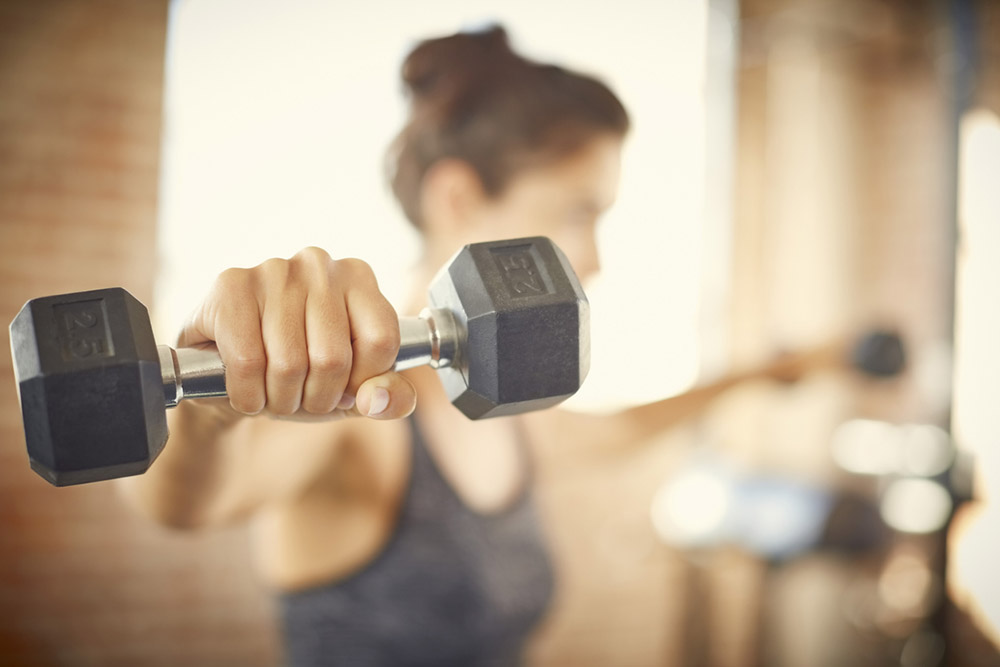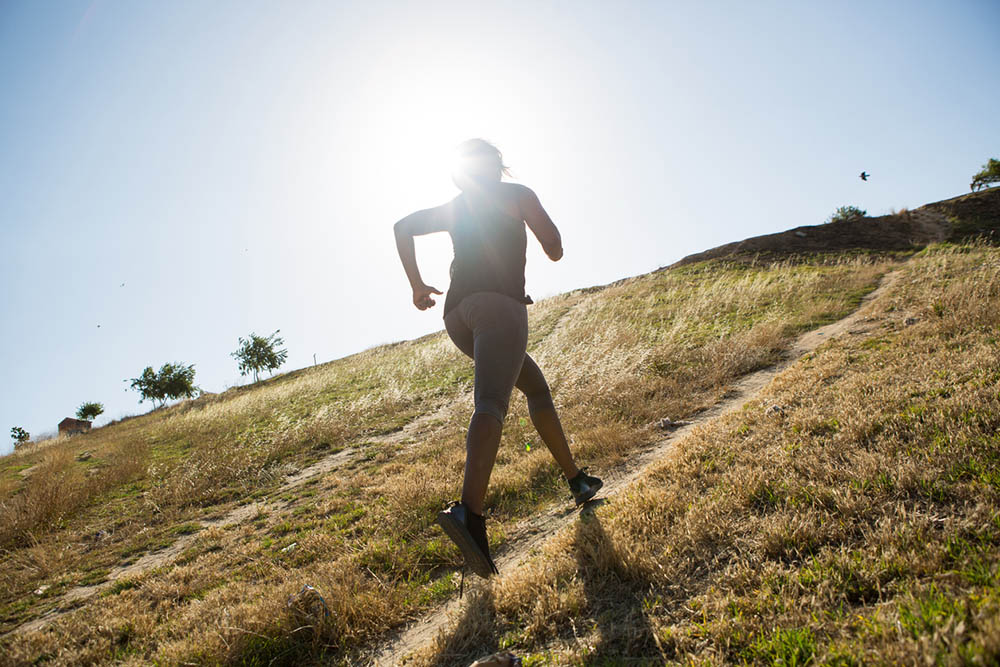Wish you could be a runner? Healthista writer and ‘beginner runner’ Olivia Hartland-Robbins spent five weeks training for a 5K run. For her final week she asked the experts how she can improve her fitness for race day
I decided it was time I became a runner. I found ‘Run Regents Park’ for Macmillan Cancer Support, then it came to me, I’ll train for the next 5 weeks and run a 5K race, 5 weeks to 5K. As I’m a writer for Healthista, I can regale you with the journey every week.
Find out how I got on in week one: Running for beginners – 7 steps to getting started, week two: Running for weight loss – 5 tips this Barry’s Bootcamp trainer wants you to know, week three: What to eat if you run, and week four: Mindfulness and running – the therapy that could change your life.

For my last week before the big race I wanted to up my fitness levels as much as I possibly could. I really don’t want to be the last gal at the back crying and refusing to go any further.
Since the start of this journey I haven’t been too bothered about timings or beating a ‘personal best’, I just wanted to be able to run a significant distance, preferably without stopping.
To complete a run no matter what speed, you still need to be reasonably fit. But how does one improve their fitness levels? Exercise – obviously, healthy diet – check.
But are there any other fitness tips and tricks that I need to know about to help me power though my 5K run? It’s my final week before the race, so I speak to the experts.
Speaking to the experts
The first expert I quizzed on all things running and fitness was personal trainer from Roar Fitness, Laura Ruthnum.
As well as personal training, Laura Ruthnum is also an endurance runner who has taken part in many many marathons, so naturally she is THE person to speak to on anything running related.
I also quizzed the two Track Life London founders, Omar Mansour and Rory Knight (both athletes themselves). Track Life London teaches you how to improve your posture and technique whilst running and how this can be used to make your running experience more productive.
Read more about my experience at Track Life London: Run like an athlete – the new London running club showing us how
I asked them all a series of running and fitness related questions and these are the top fitness running tips they recommended.
Running for fitness tip #1 Be consistent with your training and set goals
So many times I have decided to start running (jogging in my case) three to four times a week, I always start positively, keeping it up for two weeks but then all of a sudden a month has passed and I have been on two runs – inconsistent or what?
Laura says that to become a better runner and improve your fitness you need to focus on consistency and prioritisation. ‘As with anything in life, going hell for leather for two weeks then dropping off for the next two weeks, won’t be conducive to good results,’ explains Laura.
Laura recommends that for the average runner, training three to four days a week versus three to four rest days is a good start if improving fitness levels is your goal.
Each week you need to gradually increase your weekly mileage (distance). ‘But obviously this is dependent on your goal,’ says Laura. ‘If you’re training for a marathon or ultra event this will be significantly higher than if 5K’s are your thing.’
‘Consistency builds good habits and is a great way to build and sustain a base fitness level,’ say Omar and Rory.
Whilst consistently sticking to your three or four training sessions a week plus gradually increasing the distance you cover, you also need to increase your running intensity. This means how ‘hard’ you are running. So if you have successfully increased the distance of your run, try to speed it up a bit – think less of a jog more of an actual run.
Rory and Omar also say that once you have mastered consistent training, you should gradually increase the intensity of your runs. ‘The body is an amazing adaptive machine. To avoid your fitness levels plateauing, challenge yourself by either increasing your intensity, frequency or duration of running,’ explain Rory and Omar. ‘However be careful not to increase all of these at once as this can cause a high risk of injury’.
‘A great way to improve your running efficiency is by having your gait (how you walk/run) measured by a professional,’ recommends Laura. ‘This will look at everything from your posture, to if you’re a heel or toe striker- great insight for any level of runner out there’.
I did this in week one and I too recommend doing this first before you start your running training. The right pair of trainers won’t only help the quality of you running technique but will also help prevent injury.

Consistency is super important to help maintain good running habits. ‘Consistency builds good habits and is a great way to build and sustain a base fitness level,’ say Omar and Rory. ‘However frequently you can train around your lifestyle, make sure you aim to stick to it’.
If you do find you are struggling to maintain consistency and find yourself losing focus, it’s probably a good idea to set some goals.
‘Setting some running goals will help keep your training focused,’ says Omar and Rory. ‘When your motivation is low and you’re debating skipping a run, reminding yourself of what you are working towards can help you push through’.
Pick a place and a time of day where you feel motivated and run with a friend who motivates you.
But obviously you have to be enjoying yourself or what’s the point right? Rory and Omar suggest making sure your running environment brings out the best in you, this will mean you enjoy yourself and are more likely to go back and do it again. So don’t go for a run if you haven’t had a great night’s sleep or if it’s raining outside, because you’ll end up having a rubbish time and never want to do it ever again.
Pick a place and a time of day where you feel motivated and run with a friend who motivates you (rather than one who says lets go and get some fish and chips instead – yes this has happened to me).
Running for fitness tip #2 Include weight lifting into your training
This is going to sound bad but whenever I come last or see anyone else come last in any sort of fitness or sport, I think to myself ‘they must be unfit’ – which may not be the case at all, and it seems unfair of me to jump to this conclusion, but it’s what always comes to mind first.
I know I said I wasn’t too bothered about beating a personal best, but as race day looms I also don’t want to be one of the last people crossing the finish line.
So I wanted to know how I can increase my speed specifically, and all the experts said the same thing – weight training. It turns out weight training is a great way to become a more powerful and therefore faster runner.

Laura explained that at Roar fitness some of the fundamental exercises that they get their clients to do are perfect for increasing your strength and power for running.
‘The deadlift is a compound exercise that is great for strengthening the posterior chain, which is essential when striding forwards,’ says Laura. ‘Another great exercise is the split squat as it focuses on the quads. The stronger your quads, the easier running will feel (note: it never actually feels easy)’.
Rory and Omar agree and say that weight training shouldn’t be overlooked, ‘If you want to improve your running, then running seems the most logical exercise selection to pick. This is true to a certain extent. Other styles of training should not be overlooked and most definitely have there place in making you a fitter, faster, stronger runner.
‘Strength training, flexibility training and technique running drills should all be added into your training schedule. These training types can help you become faster but also prevent injury from the constant repetitive impact running has on the body’.
Laura has another important tip – don’t forget to warm up.
Another great way to become a faster is by doing speed sessions, also known as interval training. Laura recommends that we should incorporate this into two of our training days. ‘Try 15 seconds flat out speed, followed by 60 seconds recovery jog or walk,’ suggests Laura. ‘Over a series of weeks, increase the speed section, and decrease the recovery’.
Interval training involves running for a set amount of time and distance followed by an immediate rest and then repeated again. ‘These sessions are typically higher in intensity and should only be done one to three times a week to allow sufficient recovery,’ suggests Rory and Omar.
It seems simple really, if you want to run faster you have to train faster.
Laura has another important tip – don’t forget to warm up. ‘An instant tip to improve your speed is to warm up. One that I religiously follow’.
Laura suggests warming up by doing these three moves: Hips Controlled Articular Rotations (CARS), hamstring walkouts and a scorpion stretch.
Running for fitness tip #3 Try hill running
Does anyone else find that walking uphill is harder than running uphill or is it just me? Well if you are like me and prefer to run uphill then this is a great way to improve your strength, speed, mental toughness and endurance for running.
‘When running up a hill you will engage the same muscles involved when you sprint. The only difference is that due to the incline there will be an added resistance,’ explain Rory and Omar. ‘Hills are a fantastic option if you can’t get to the gym and want to help strengthen your leg muscles’.
Hills are a fantastic option if you can’t get to the gym.
‘Most runners will have a love hate relationship with hill training,’ says Laura. ‘With every step, your speed improves and your stride becomes more efficient’.
The International Journal of Sports Physiology and Performance ran a study in 2015 which showed that after 6 weeks of running uphill, runners were on average two per cent faster in their 5K time trial. That’s about 30 seconds off a 30 minute time (by the way 30 seconds is a very big deal to all those pro runners out there).

If you are a beginner Laura says you may want to ease yourself slowly into hill running. ‘I wouldn’t recommend it if you’re a total beginner as it requires a significant amount of co-ordination, and quite a quick cadence. That being said, once you can cover a 5km distance, I think its a great way to ramp up the intensity and start to see some real improvements.’
For a beginner runner Laura suggests that you start with a ten minute jog to warm up, then run uphill for five seconds and jog back down. Then run uphill for seven seconds and jog back down. Next, run uphill for ten seconds and jog back down. Repeat this three to five times.
More experienced runners could try sprinting up a steep hill for seven to 12 seconds, giving it your full effort, then walking back down, focusing on recovering your breathing. Repeat this eight to ten times.
One of Rory and Omar’s favourite quick hill sessions is a one mile warm up run, followed by 30 seconds hill sprints (90-95% effort), then a 30 second recover jog back down the hill, repeat this 12 times. Then go for a one mile warm down run. (I’m pretty sure this isn’t for beginners, but if you’ve been running for a while then go for it).
Running for fitness tip #4 Time yourself
Okay so again, I know I said I didn’t care about completing the race in a set time or beating a personal best, but according to the experts, for fitness reasons I may need to pay more attention to this than I originally planned.
With that said what time should I be aiming to complete a 5K in? 20 minutes? Half an hour? An hour? I’m clueless. So far I’m lucky if I can run for 15 minutes – honestly what have I gotten myself into!
As a beginner, Laura said that 5K is a great distance to focus your training towards, and a good time to aim for is 30 minutes. Many speedy runners aim for about 20 minutes when doing a 5K, but Laura says that 30 minutes is a great achievement too.
Rory and Omar also say that 30 minutes is around the average time it takes for people to run 5K, but with consistent training you can easily expect that time to decrease.
To hit this target time the experts suggest that you should try and keep a steady pace throughout, but when you know you’re on the home stretch, try to pick up the pace and give it everything you’ve got.
So when training, time yourself. If you can run 5K in 30 minutes on one day, try and gradually decrease that time with each run. This will help you to keep a tab on your improving fitness levels and help you set and strive towards new goals.

Running for fitness tip #5 Sometimes slow and steady will help you win the race
So, the experts have suggested consistency, interval speed training, weight training and hill running. But what about those days where you aren’t feeling tip top and you just want to go for a steady run, or a mindful run, will this be any help towards improving my fitness goals?
Laura says that steady state runs are a great tool for building your foundation in running. ‘These can help you improve your ability to run at a ‘comfortably hard’ pace for longer. If you’re training for anything over a 5km, they’re a great addition to your training’.
Longer runs will help improve your cardiovascular endurance.
Laura suggested that a typical training week should include; one speed session, one hill session, one steady state run and one long run.
‘Over a period of weeks, the intensity of each session (distance and pace) should increase, but the general structure should remain the same,’ says Laura. ‘This will help to improve your fitness, get you running quicker, whilst allowing your body the time it needs to recover’.
‘Longer runs will help improve your cardiovascular endurance whilst interval training will help improve your speed,’ add Rory and Omar.
So the answer to my question is yes steady runs will still improve your fitness levels.
So what have I learnt?
Well I may have left it a bit too late with the whole consistency thing, but I can at least give the ‘typical training week’ a go.
Well I did give it a go, and let me tell you it wasn’t easy by any means, but changing it up between speed training, slow jogging and ‘attempting’ to run up a hill, made training exciting and kept me on my toes – literally.
I particularly liked the interval training, this was very similar to the training I did at Barry’s Bootcamp. Interval training brought out my competitive side and I found I was racing against myself to hit certain distances in certain times (being a Londoner I measure distances by lampposts and traffic lights – who else does this?)
The hill sprinting was a challenge and boy did I ache the next day, I mean I practically fell out of bed when I tried to get up.
I had a two day rest and felt the need to go for a run. Before I left I told myself ‘do not stop until you absolutely have to’. Well guess what? I only went and ran 4K without stopping – amazing.
My race is now three days away, do you think I will be able to tackle the 5K? Tune in next week to find out.
‘Run when you can, walk if you have to, crawl if you must; just never give up.’ Dean Karnazes.
More Healthista Content:
PMS symptoms? These 4 natural remedies will help
This is London’s most exhilarating yoga class
6 drug-free insomnia fixes you can do tonight
Karl Lagerfeld lost 93 pounds in 13 months with this strange diet psychology
WIN an overnight spa stay worth £279 by taking our 5-minute survey
Do you want to experience ultimate relaxation? To be in with a chance to win an overnight spa stay for two including treatments and meals, complete our five minute survey about how your gut health affects your relationships
Like this article? Sign up to our newsletter to get more articles like this delivered straight to your inbox.






















































